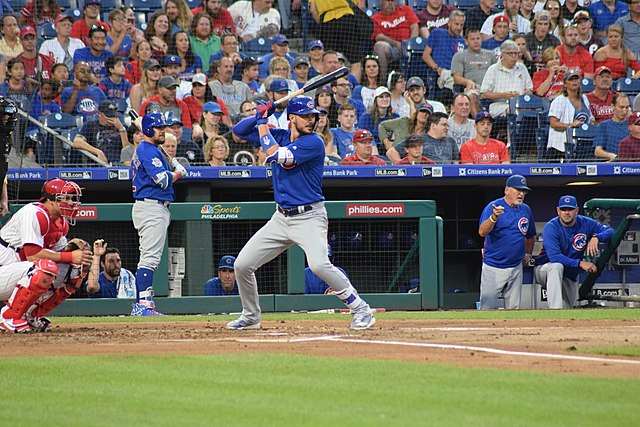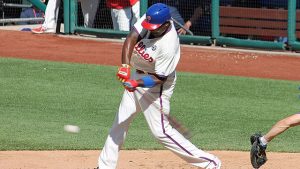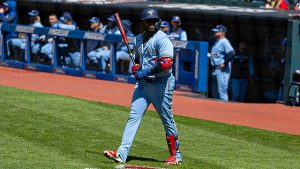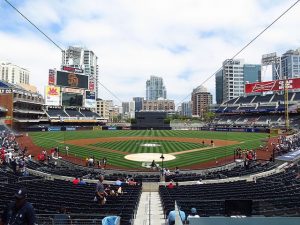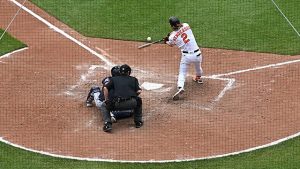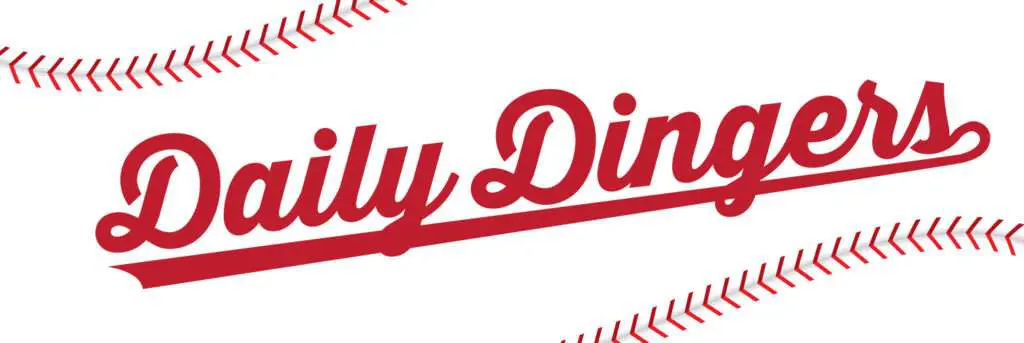Last Updated on November 16, 2023 by Matt Musico
If you’ve ever wondered which hitters are the Cubs single season HR leaders at each position, then you’re in the right place. Outside of pitcher and designated hitter, each player had to qualify for the batting title. Each player also had to man their position for at least 75% of the season in question.
After you’re done checking this out, head on over to the Cubs’ all-time and single-season home run leaderboards.
Want to see the Cubs slug dingers in person? Grab tickets from our friends at Vivid Seats. And before you get to the stadium, make sure you’re decked out in the right gear. Get official Cubs merch from the MLB Shop or a ‘Big Dinger Energy’ shirt from our apparel store.
Cubs Single Season HR Leaders
Catcher: Gabby Hartnett, 1930: 37 Home Runs
Gabby Hartnett was no stranger to producing at the plate during his big-league career. Over his 20 years in Major League Baseball, he produced a lifetime .297 batting average with 236 home runs and 1,179 RBI. But, it’s also fair to say his 1930 performance kinda came out of nowhere.
Between 1922 and 1929, Hartnett slugged more than 20 homers once (24 in 1925). Heck, he only suited up for 25 games (and 29 plate appearances) in 1929. It resulted in a .984 OPS, but also just one homer. Then came 1930, where he slashed .339/.396/.630 with those 37 homers, 31 doubles, 122 RBI, and 84 runs scored.
Hartnett was good throughout most of the year, but the three-month span between June and August is what really made his season special. Through the end of May, he was hitting .271/.329/.473 with five homers and 18 RBI. Between June and August (332 plate appearances), the Hall of Fame backstop slashed .388/.462/.720 with 23 homers and 81 RBI.
Pitcher: Ad Gumbert, 1889: 7 Home Runs
The 1889 season was Ad Gumbert‘s first full year in the big leagues, and he made it count on both ends. He appeared in 31 games (28 starts) on the mound, leading to a 16-13 record, 3.62 ERA, and 1.36 WHIP. The hurler was a solid hitter throughout his career (.275/.338/.396 line over nine years), but nothing was quite like his second year in the majors.
Those seven homers were part of the 12 total extra-base hits he accumulated (three doubles, two triples). He slashed .288/.339/.471 with a single-season career-high 29 RBI, too. Gumbert slugged another three dingers the following year in Boston and then never hit that many in one year again. His career finished with 15 total homers, so two-thirds of them came between 1889 and 1890.
First Base: Derrek Lee, 2005: 46 Home Runs
After winning a World Series with the Florida Marlins in 2003, Derrek Lee headed for the Windy City and Wrigley Field starting in 2004. That debut campaign was solid. It included a .278/.356/.504 line with 32 home runs and 98 RBI. Lee followed that up with an MVP-caliber performance, though.
In 691 trips to the plate in 2005, he slashed .335/.418/.662 with 46 home runs, 50 doubles, 107 RBI, and 120 runs scored. He led the league in batting average, slugging percentage, doubles, and total hits (199). Lee finished third in NL MVP voting while also earning his first All-Star Game selection, his first Silver Slugger Award, and his second Gold Glove Award.
The first baseman was consistent in his monthly power numbers. He either hit seven (April, June, August, September) or nine homers (May and July). The entire year was noteworthy for Lee, but his first four months were a cut above the rest. The Cubs were just 52-50 during this 102-game stretch, but the right-handed hitter slashed .360/.437/.697 with 32 homers, 31 doubles, 83 RBI, and 81 runs scored.
Second Base: Ryne Sandberg, 1990: 40 Home Runs
It’s safe to say Ryne Sandberg found his power stroke during the later years of his Hall of Fame career. Between 1981 and 1988, he posted five years of double-digit homers, but just one of them finished beyond 20 (26 in ’85). From 1989 to 1997, he slugged 20-plus dingers five times.
And between 1989 and 1990, Sandberg hit 70 of his 282 career home runs. He led the league in homers, runs scored (116), and total bases (344) in ’90 on his way to a fourth-place finish in NL MVP voting. He also earned one of his nine Gold Gloves and one of his seven Silver Sluggers in the process.
When looking at Ryno’s monthly splits, it was a feast-or-famine scenario for the second baseman. There were two months where he hit just one homer (April and July). There were also three months where he hit at least nine dingers (May, June, September).
His start to the year was rough. Sandberg’s first 79 plate appearances led to that one homer, seven RBI, and a .250/.266/.329 line. The next two months got him on the right track, though. In the 259 plate appearances that followed, he slashed .375/.432/.737 with 23 homers and 46 RBI.
Shortstop: Ernie Banks, 1958: 47 Home Runs
Before Sammy Sosa overtook him in both the single-season and all-time franchise leaderboards, Ernie Banks was Cubs home run royalty. Well, he still is. That’s what happens when all 512 of your career homers come with one organization.
Banks’ 1958 campaign was his first of two straight MVP performances. It was also the second straight year he slugged 40-plus dingers. In this particular year, Banks really enjoyed hitting at Wrigley. The shortstop slugged 30 of his 47 homers in Chicago, while his OPS (1.093) was more than 200 points better than what he did on the road (.872).
Banks really caught fire in the power department between July and August, slugging 24 total homers. He reached double digits on both occasions. These were the only times he hit more than eight in a month during the year.
Third Base: Kris Bryant, 2016: 39 Home Runs
https://www.youtube.com/watch?v=NHhhr9MDN4A
Fresh off winning National League Rookie of the Year honors, all Kris Bryant did was follow that up with an MVP performance and a World Series title. That’s a decent sequel.
Outside of having a tough September (.671 OPS in 115 plate appearances), he was consistently elite all year. The best of all was in August. In 127 trips to the plate, Bryant slashed .383/.472/.748 with 10 homers and 22 RBI.
One thing also evident was when Bryant homered, it usually meant good things for the Cubs. In wins, the third baseman slugged 34 of his 39 homers and produced a 1.131 OPS. Obviously, only five of his homers came in Chicago losses, which was accompanied by a .592 OPS.
Cubs Single Season HR Leaders
Left Field: Dave Kingman, 1979: 48 Home Runs
Dave Kingman would’ve fit in with today’s version of MLB quite well. During his 16-year career, he led the league in homers twice and strikeouts three times. On two occasions, both of those things happened during the same year. The first occurrence was in ’79 with the Cubs. In addition to those 48 dingers, he also compiled a league-high 131 strikeouts, as well as a .613 slugging percentage and .956 OPS.
His performance was quite solid all year, as his monthly OPS never dipped below .830. Kingman slugged 15 homers between the first two months, and then nearly doubled his season-long total in June with another 12. That performance was accompanied by a .329/.396/.835 line and 25 RBI in just 96 plate appearances.
Kingman’s OPS got consistently better as an inning wore on, too. With no outs, he owned a .830 OPS. That jumped up to .964 with one out and then again to 1.083 with two outs.
Center Field: Hack Wilson, 1930: 56 Home Runs
This performance by Hack Wilson is also tied with Ken Griffey Jr. for the most single-season homers by a center fielder in MLB history. Furthermore, the 191 RBI he accumulated set a new league record that will probably never be broken.
What I find interesting is Wilson had just four homers and 11 RBI to his name by the end of April (16 games). So, he clearly just went off the remaining five months. The Cubs went 31-23 over the final two months of the regular season, and that’s when Wilson hit another gear. He slashed .381/.472/.758 with 23 home runs, 87 RBI, and 50 runs scored in 262 plate appearances.
While he still posted a .945 OPS in losses, what he did in Cub victories jumps off the page. Wilson accumulated 40 of his homers and 145 of his RBI in wins that year and paired it with a .404/.498/.853 triple slash.
Right Field: Sammy Sosa, 1998: 66 Home Runs
Sammy Sosa’s 1998 campaign is one of the most powerful seasons in MLB history. You just knew this had to be here, right? The one month everyone talks about Sosa’s historic performance is June. He entered the month with 13 homers and 39 RBI. Once the calendar flipped to July, the outfielder’s season-long totals were at 33 dingers and 79 RBI.
Although the majority of his power production happened in wins (37 homers, 103 RBI) when compared to losses (29 homers, 55 RBI), it’s interesting to see how similar his triple slash is in both instances. In victories, Sosa hit .308/.382/.661. In losses, it was .308/.371/.630.
So, it didn’t matter what opposing teams did that year — nobody was going to stop Sosa. The key to beating the Cubs was to make sure there weren’t a lot of runners on base when he stepped to the plate.
Designated Hitter: Christopher Morel, 2023: 13 Home Runs
Christopher Morel hit 16 homers in 425 plate appearances as a rookie in 2022. Despite getting just four more trips to the plate in 2023, he upped his single-season career-high total to 26. As we can see, 13 of those dingers came as Chicago’s designated hitter.
He drove in 39 runs and scored 27 more while slashing .225/.288/.477 in that situation. Morel really got everyone’s attention once he made his season debut in May. Across 75 plate appearances that month, he posted a 1.052 OPS with nine homers and 16 RBI.
Morel went on to hit 10 homers over the next three months before slugging seven in September/October.
Want to see some homers in person this season? Of course you do. Grab MLB tickets from our friends at Vivid Seats. And before you get to the stadium, make sure you’re decked out in the right gear. Get your favorite team’s official merch from the MLB Shop or a ‘Big Dinger Energy’ shirt from our apparel store.
